IEEE TRANSACTIONS ON KNOWLEDGE AND DATA ENGINEERING, VOL. 22, NO. 10, OCTOBER 2010
1345
A Survey on Transfer Learning
Sinno Jialin Pan and Qiang Yang, Fellow, IEEE
Abstract—A major assumption in many machine learning and data mining algorithms is that the training and future data must be in the
same feature space and have the same distribution. However, in many real-world applications, this assumption may not hold. For
example, we sometimes have a classification task in one domain of interest, but we only have sufficient training data in another domain
of interest, where the latter data may be in a different feature space or follow a different data distribution. In such cases, knowledge
transfer, if done successfully, would greatly improve the performance of learning by avoiding much expensive data-labeling efforts. In
recent years, transfer learning has emerged as a new learning framework to address this problem. This survey focuses on categorizing
and reviewing the current progress on transfer learning for classification, regression, and clustering problems. In this survey, we
discuss the relationship between transfer learning and other related machine learning techniques such as domain adaptation, multitask
learning and sample selection bias, as well as covariate shift. We also explore some potential future issues in transfer learning
research.
Index Terms—Transfer learning, survey, machine learning, data mining.
Ç
1 INTRODUCTION
DATA mining and machine learning technologies have
already achieved significant success in many knowl-
edge engineering areas including classification, regression,
and clustering (e.g., [1], [2]). However, many machine
learning methods work well only under a common assump-
tion: the training and test data are drawn from the same
feature space and the same distribution. When the distribu-
tion changes, most statistical models need to be rebuilt from
scratch using newly collected training data. In many real-
world applications, it is expensive or impossible to recollect
the needed training data and rebuild the models. It would be
nice to reduce the need and effort to recollect the training
data. In such cases, knowledge transfer or transfer learning
between task domains would be desirable.
Many examples in knowledge engineering can be found
where transfer learning can truly be beneficial. One
example is Web-document classification [3], [4], [5], where
our goal is to classify a given Web document into several
predefined categories. As an example, in the area of Web-
document classification (see, e.g., [6]), the labeled examples
may be the university webpages that are associated with
category information obtained through previous manual-
labeling efforts. For a classification task on a newly created
website where the data features or data distributions may
be different, there may be a lack of labeled training data. As
a result, we may not be able to directly apply the webpage
classifiers learned on the university website to the new
website. In such cases, it would be helpful if we could
transfer the classification knowledge into the new domain.
. The authors are with the Department of Computer Science and
Engineering, Hong Kong University of Science and Technology,
Clearwater Bay, Kowloon, Hong Kong.
E-mail: {sinnopan, qyang}@cse.ust.hk.
Manuscript received 13 Nov. 2008; revised 29 May 2009; accepted 13 July
2009; published online 12 Oct. 2009.
Recommended for acceptance by C. Clifton.
For information on obtaining reprints of this article, please send e-mail to:
tkde@computer.org, and reference IEEECS Log Number TKDE-2008-11-0600.
Digital Object Identifier no. 10.1109/TKDE.2009.191.
In this case,
The need for transfer learning may arise when the data
can be easily outdated.
the labeled data
obtained in one time period may not follow the same
distribution in a later time period. For example, in indoor
WiFi localization problems, which aims to detect a user’s
current location based on previously collected WiFi data, it
is very expensive to calibrate WiFi data for building
localization models in a large-scale environment, because
a user needs to label a large collection of WiFi signal data at
each location. However, the WiFi signal-strength values
may be a function of time, device, or other dynamic factors.
A model trained in one time period or on one device may
cause the performance for location estimation in another
time period or on another device to be reduced. To reduce
the recalibration effort, we might wish to adapt
the
localization model trained in one time period (the source
domain) for a new time period (the target domain), or to
adapt the localization model trained on a mobile device (the
source domain)
for a new mobile device (the target
domain), as done in [7].
As a third example, consider the problem of sentiment
classification, where our task is to automatically classify the
reviews on a product, such as a brand of camera, into
positive and negative views. For this classification task, we
need to first collect many reviews of the product and
annotate them. We would then train a classifier on the
reviews with their corresponding labels. Since the distribu-
tion of review data among different types of products can be
very different, to maintain good classification performance,
we need to collect a large amount of labeled data in order to
train the review-classification models for each product.
However, this data-labeling process can be very expensive to
do. To reduce the effort for annotating reviews for various
products, we may want to adapt a classification model that is
trained on some products to help learn classification models
for some other products. In such cases, transfer learning can
save a significant amount of labeling effort [8].
In this survey paper, we give a comprehensive overview
of transfer learning for classification, regression, and cluster-
1041-4347/10/$26.00 ß 2010 IEEE
Published by the IEEE Computer Society
�
1346
IEEE TRANSACTIONS ON KNOWLEDGE AND DATA ENGINEERING, VOL. 22, NO. 10, OCTOBER 2010
ing developed in machine learning and data mining areas.
There has been a large amount of work on transfer learning
for reinforcement learning in the machine learning literature
(e.g., [9], [10]). However, in this paper, we only focus on
transfer learning for classification, regression, and clustering
problems that are related more closely to data mining tasks.
By doing the survey, we hope to provide a useful resource for
the data mining and machine learning community.
The rest of the survey is organized as follows: In the next
four sections, we first give a general overview and define
some notations we will use later. We, then, briefly survey the
history of transfer learning, give a unified definition of
transfer learning and categorize transfer learning into three
different settings (given in Table 2 and Fig. 2). For each
setting, we review different approaches, given in Table 3 in
detail. After that, in Section 6, we review some current
research on the topic of “negative transfer,” which happens
when knowledge transfer has a negative impact on target
learning. In Section 7, we introduce some successful
applications of transfer learning and list some published
data sets and software toolkits for transfer learning research.
Finally, we conclude the paper with a discussion of future
works in Section 8.
2 OVERVIEW
2.1 A Brief History of Transfer Learning
Traditional data mining and machine learning algorithms
make predictions on the future data using statistical models
that are trained on previously collected labeled or unlabeled
training data [11], [12], [13]. Semisupervised classification
[14], [15], [16], [17] addresses the problem that the labeled
data may be too few to build a good classifier, by making use
of a large amount of unlabeled data and a small amount of
labeled data. Variations of supervised and semisupervised
learning for imperfect data sets have been studied; for
example, Zhu and Wu [18] have studied how to deal with the
noisy class-label problems. Yang et al. considered cost-
sensitive learning [19] when additional tests can be made to
future samples. Nevertheless, most of them assume that the
distributions of the labeled and unlabeled data are the same.
Transfer learning, in contrast, allows the domains, tasks, and
distributions used in training and testing to be different. In
the real world, we observe many examples of transfer
learning. For example, we may find that learning to
recognize apples might help to recognize pears. Similarly,
learning to play the electronic organ may help facilitate
learning the piano. The study of Transfer learning is motivated
by the fact that people can intelligently apply knowledge
learned previously to solve new problems faster or with
better solutions. The fundamental motivation for Transfer
learning in the field of machine learning was discussed in a
NIPS-95 workshop on “Learning to Learn,”1 which focused
on the need for lifelong machine learning methods that retain
and reuse previously learned knowledge.
Research on transfer learning has attracted more and
more attention since 1995 in different names: learning to
learn,
inductive
life-long learning, knowledge transfer,
1. http://socrates.acadiau.ca/courses/comp/dsilver/NIPS95_LTL/
transfer.workshop.1995.html.
Fig. 1. Different learning processes between (a) traditional machine
learning and (b) transfer learning.
transfer, multitask learning, knowledge consolidation,
context-sensitive learning, knowledge-based inductive bias,
metalearning, and incremental/cumulative learning [20].
Among these, a closely related learning technique to
transfer learning is the multitask learning framework [21],
which tries to learn multiple tasks simultaneously even
when they are different. A typical approach for multitask
learning is to uncover the common (latent) features that can
benefit each individual task.
In 2005, the Broad Agency Announcement (BAA) 05-29
of Defense Advanced Research Projects Agency (DARPA)’s
Information Processing Technology Office (IPTO)2 gave a
new mission of transfer learning: the ability of a system to
recognize and apply knowledge and skills learned in
previous tasks to novel tasks. In this definition, transfer
learning aims to extract the knowledge from one or more
source tasks and applies the knowledge to a target task. In
contrast to multitask learning, rather than learning all of the
source and target tasks simultaneously, transfer learning
cares most about the target task. The roles of the source and
target tasks are no longer symmetric in transfer learning.
Fig. 1 shows the difference between the learning processes
of traditional and transfer learning techniques. As we can
see, traditional machine learning techniques try to learn each
task from scratch, while transfer learning techniques try to
transfer the knowledge from some previous tasks to a target
task when the latter has fewer high-quality training data.
Today, transfer learning methods appear in several top
venues, most notably in data mining (ACM KDD, IEEE
ICDM, and PKDD, for example), machine learning (ICML,
NIPS, ECML, AAAI, and IJCAI, for example) and applica-
tions of machine learning and data mining (ACM SIGIR,
WWW, and ACL, for example).3 Before we give different
categorizations of transfer learning, we first describe the
notations used in this paper.
2.2 Notations and Definitions
In this section, we introduce some notations and definitions
that are used in this survey. First of all, we give the
definitions of a “domain” and a “task,” respectively.
In this survey, a domain D consists of two components: a
feature spaceX and a marginal probability distribution PðXÞ,
where X ¼ fx1; . . . ; xng 2 X . For example, if our learning task
2. http://www.darpa.mil/ipto/programs/tl/tl.asp.
3. We summarize a list of conferences and workshops where transfer
learning papers appear in these few years in the following webpage for
reference, http://www.cse.ust.hk/~sinnopan/conferenceTL.htm.
�
PAN AND YANG: A SURVEY ON TRANSFER LEARNING
1347
Relationship between Traditional Machine Learning and Various Transfer Learning Settings
TABLE 1
is document classification, and each term is taken as a binary
feature, thenX is the space of all term vectors, xi is the ith term
vector corresponding to some documents, and X is a
particular learning sample. In general, if two domains are
different, then they may have different feature spaces or
different marginal probability distributions.
Given a specific domain, D ¼ fX ; PðXÞg, a task consists
of two components: a label space Y and an objective
predictive function fð�Þ (denoted by T ¼ fY; fð�Þg), which is
not observed but can be learned from the training data,
which consist of pairs fxi; yig, where xi 2 X and yi 2 Y. The
function fð�Þ can be used to predict the corresponding label,
fðxÞ, of a new instance x. From a probabilistic viewpoint,
fðxÞ can be written as PðyjxÞ. In our document classification
example, Y is the set of all labels, which is True, False for a
binary classification task, and yi is “True” or “False.”
For simplicity, in this survey, we only consider the case
where there is one source domain DS, and one target domain,
DT , as this is by far the most popular of the research works in
the literature. More specifically, we denote the source domain
data as DS ¼ fðxS1 ; yS1Þ; . . . ;ðxSnS
Þg, where xSi 2 X S is
the data instance and ySi 2 YS is the corresponding class
label. In our document classification example, DS can be a set
of term vectors together with their associated true or false
class labels. Similarly, we denote the target-domain data as
DT ¼ fðxT1 ; yT1Þ; . . . ;ðxTnT
Þg, where the input xTi is in
X T and yTi 2 YT is the corresponding output. In most cases,
0 � nT � nS.
; ySnS
; yTnT
We now give a unified definition of transfer learning.
Definition 1 (Transfer Learning). Given a source domain DS
and learning task T S, a target domain DT and learning task
T T , transfer learning aims to help improve the learning of the
target predictive function fTð�Þ in DT using the knowledge in
DS and T S, where DS 6¼ DT , or T S 6¼ T T .
In the above definition, a domain is a pair D ¼ fX ; PðXÞg.
Thus, the condition DS 6¼ DT implies that either X S 6¼ X T or
PSðXÞ 6¼ PTðXÞ. For example, in our document classification
example, this means that between a source document set and
a target document set, either the term features are different
between the two sets (e.g., they use different languages), or
their marginal distributions are different.
Similarly, a task is defined as a pair T ¼ fY; PðY jXÞg.
Thus, the condition T S 6¼ T T implies that either YS 6¼ YT or
PðYSjXSÞ 6¼ PðYTjXTÞ. When the target and source domains
are the same, i.e., DS ¼ DT , and their learning tasks are the
the learning problem becomes a
same,
traditional machine learning problem. When the domains
are different, then either 1) the feature spaces between the
domains are different, i.e., X S 6¼ X T , or 2) the feature spaces
between the domains are the same but the marginal
i.e., T S ¼ T T ,
probability distributions between domain data are different;
i.e., PðXSÞ 6¼ PðXTÞ, where XSi 2 X S and XTi 2 X T . As an
example, in our document classification example, case 1
corresponds to when the two sets of documents are
described in different languages, and case 2 may correspond
to when the source domain documents and the target-
domain documents focus on different topics.
Given specific domains DS and DT , when the learning
tasks T S and T T are different, then either 1) the label
spaces between the domains are different, i.e., YS 6¼ YT , or
2) the conditional probability distributions between the
domains are different; i.e., PðYSjXSÞ 6¼ PðYTjXTÞ, where
YSi 2 YS and YTi 2 YT .
In our document classification
example, case 1 corresponds to the situation where source
domain has binary document classes, whereas the target
domain has 10 classes to classify the documents to. Case 2
corresponds to the situation where the source and target
documents are very unbalanced in terms of the user-
defined classes.
In addition, when there exists some relationship, explicit
or implicit, between the feature spaces of the two domains,
we say that the source and target domains are related.
2.3 A Categorization of
Transfer Learning Techniques
In transfer learning, we have the following three main
research issues: 1) what to transfer, 2) how to transfer, and
3) when to transfer.
“What to transfer” asks which part of knowledge can be
transferred across domains or tasks. Some knowledge is
specific for individual domains or tasks, and some knowl-
edge may be common between different domains such that
they may help improve performance for the target domain or
task. After discovering which knowledge can be transferred,
learning algorithms need to be developed to transfer the
knowledge, which corresponds to the “how to transfer” issue.
“When to transfer” asks in which situations, transferring
skills should be done. Likewise, we are interested in
knowing in which situations, knowledge should not be
transferred. In some situations, when the source domain
and target domain are not related to each other, brute-force
transfer may be unsuccessful. In the worst case, it may
even hurt
learning in the target
domain, a situation which is often referred to as negative
transfer. Most current work on transfer learning focuses on
“What to transfer” and “How to transfer,” by implicitly
assuming that the source and target domains be related to
each other. However, how to avoid negative transfer is an
important open issue that is attracting more and more
attention in the future.
the performance of
Based on the definition of transfer learning, we summarize
the relationship between traditional machine learning and
various transfer learning settings in Table 1, where we
�
1348
IEEE TRANSACTIONS ON KNOWLEDGE AND DATA ENGINEERING, VOL. 22, NO. 10, OCTOBER 2010
TABLE 2
Different Settings of Transfer Learning
categorize transfer learning under three subsettings, inductive
transfer learning, transductive transfer learning, and unsuper-
vised transfer learning, based on different situations between
the source and target domains and tasks.
1.
In the inductive transfer learning setting, the target task
is different from the source task, no matter when the
source and target domains are the same or not.
In this case, some labeled data in the target
domain are required to induce an objective predictive
model fTð�Þ for use in the target domain. In addition,
according to different situations of
labeled and
unlabeled data in the source domain, we can further
categorize the inductive transfer learning setting into
two cases:
a. A lot of labeled data in the source domain are
available. In this case, the inductive transfer
learning setting is similar to the multitask learning
setting. However, the inductive transfer learning
setting only aims at achieving high performance
in the target task by transferring knowledge from
the source task while multitask learning tries to
learn the target and source task simultaneously.
b. No labeled data in the source domain are
available.
the inductive transfer
learning setting is similar to the self-taught
learning setting, which is first proposed by Raina
et al. [22]. In the self-taught learning setting, the
label spaces between the source and target
domains may be different, which implies the
side information of the source domain cannot be
used directly. Thus, it’s similar to the inductive
transfer learning setting where the labeled data
in the source domain are unavailable.
In this case,
In the transductive transfer learning setting, the source
and target tasks are the same, while the source and
target domains are different.
In this situation, no labeled data in the target
domain are available while a lot of labeled data in
the source domain are available.
In addition,
according to different situations between the source
and target domains, we can further categorize the
transductive transfer learning setting into two cases.
a. The feature spaces between the source and
target domains are different, X S 6¼ X T .
b. The feature spaces between domains are the
same, X S ¼ X T , but the marginal probability
2.
3.
distributions of the input data are different,
PðXSÞ 6¼ PðXTÞ.
The latter case of the transductive transfer
learning setting is related to domain adaptation
for knowledge transfer in text classification [23]
and sample selection bias [24] or covariate shift
[25], whose assumptions are similar.
Finally, in the unsupervised transfer learning setting,
similar to inductive transfer learning setting, the target
task is different from but related to the source task.
However, the unsupervised transfer learning focus on
solving unsupervised learning tasks in the target
domain, such as clustering, dimensionality reduction,
and density estimation [26], [27]. In this case, there are
no labeled data available in both source and target
domains in training.
The relationship between the different settings of
transfer learning and the related areas are summarized in
Table 2 and Fig. 2.
Approaches to transfer learning in the above three
different settings can be summarized into four cases based
on “What to transfer.” Table 3 shows these four cases and
brief description. The first context can be referred to as
instance-based transfer learning (or instance transfer)
approach [6], [28], [29], [30], [31], [24], [32], [33], [34], [35],
which assumes that certain parts of the data in the source
domain can be reused for learning in the target domain by
reweighting. Instance reweighting and importance sampling
are two major techniques in this context.
A second case can be referred to as feature-representa-
tion-transfer approach [22], [36], [37], [38], [39], [8], [40],
[41], [42], [43], [44]. The intuitive idea behind this case is to
learn a “good” feature representation for the target domain.
In this case, the knowledge used to transfer across domains
is encoded into the learned feature representation. With the
new feature representation, the performance of the target
task is expected to improve significantly.
A third case can be referred to as parameter-transfer
approach [45], [46], [47], [48], [49], which assumes that the
source tasks and the target tasks share some parameters or
prior distributions of the hyperparameters of the models. The
transferred knowledge is encoded into the shared para-
meters or priors. Thus, by discovering the shared parameters
or priors, knowledge can be transferred across tasks.
Finally, the last case can be referred to as the relational-
knowledge-transfer problem [50], which deals with transfer
learning for relational domains. The basic assumption
�
PAN AND YANG: A SURVEY ON TRANSFER LEARNING
1349
Fig. 2. An overview of different settings of transfer.
behind this context is that some relationship among the data
in the source and target domains is similar. Thus, the
knowledge to be transferred is the relationship among the
data. Recently, statistical relational
learning techniques
dominate this context [51], [52].
Table 4 shows the cases where the different approaches
are used for each transfer learning setting. We can see that
the inductive transfer learning setting has been studied in
many research works, while the unsupervised transfer
learning setting is a relatively new research topic and only
studied in the context of the feature-representation-transfer
case. In addition, the feature-representation-transfer problem
has been proposed to all three settings of transfer learning.
However, the parameter-transfer and the relational-knowledge-
transfer approach are only studied in the inductive transfer
learning setting, which we discuss in detail below.
3 INDUCTIVE TRANSFER LEARNING
Definition 2 (Inductive Transfer Learning). Given a source
domain DS and a learning task T S, a target domain DT
and a learning task T T , inductive transfer learning aims
to help improve the learning of the target predictive function
fTð�Þ in DT using the knowledge in DS and T S, where
T S 6¼ T T .
Based on the above definition of the inductive transfer
learning setting, a few labeled data in the target domain are
required as the training data to induce the target predictive
function. As mentioned in Section 2.3, this setting has two
cases: 1) labeled data in the source domain are available and
2) labeled data in the source domain are unavailable while
unlabeled data in the source domain are available. Most
transfer learning approaches in this setting focus on the
former case.
3.1 Transferring Knowledge of Instances
The instance-transfer approach to the inductive transfer
learning setting is intuitively appealing: although the source
domain data cannot be reused directly, there are certain
parts of the data that can still be reused together with a few
labeled data in the target domain.
Dai et al. [6] proposed a boosting algorithm, TrAdaBoost,
which is an extension of the AdaBoost algorithm, to address
the inductive transfer learning problems. TrAdaBoost assumes
that the source and target-domain data use exactly the same
Different Approaches to Transfer Learning
TABLE 3
�
1350
IEEE TRANSACTIONS ON KNOWLEDGE AND DATA ENGINEERING, VOL. 22, NO. 10, OCTOBER 2010
Different Approaches Used in Different Settings
TABLE 4
set of features and labels, but the distributions of the data in
the two domains are different. In addition, TrAdaBoost
assumes that, due to the difference in distributions between
the source and the target domains, some of the source
domain data may be useful
in learning for the target
domain but some of them may not and could even be
harmful. It attempts to iteratively reweight
the source
domain data to reduce the effect of the “bad” source data
while encourage the “good” source data to contribute more
for the target domain. For each round of
iteration,
TrAdaBoost trains the base classifier on the weighted source
and target data. The error is only calculated on the target
data. Furthermore, TrAdaBoost uses the same strategy as
AdaBoost to update the incorrectly classified examples in the
target domain while using a different strategy from
AdaBoost to update the incorrectly classified source exam-
ples in the source domain. Theoretical analysis of TrAda-
Boost in also given in [6].
Jiang and Zhai [30] proposed a heuristic method to
remove “misleading” training examples from the source
domain based on the difference between conditional
probabilities PðyTjxTÞ and PðySjxSÞ. Liao et al.
[31]
proposed a new active learning method to select
the
unlabeled data in a target domain to be labeled with the
help of the source domain data. Wu and Dietterich [53]
integrated the source domain (auxiliary) data an Support
Vector Machine (SVM)
framework for improving the
classification performance.
3.2 Transferring Knowledge of Feature
Representations
The feature-representation-transfer approach to the induc-
tive transfer learning problem aims at finding “good” feature
representations to minimize domain divergence and classi-
fication or regression model error. Strategies to find “good”
feature representations are different for different types of
the source domain data. If a lot of labeled data in the source
domain are available, supervised learning methods can be
used to construct a feature representation. This is similar to
common feature learning in the field of multitask learning
[40]. If no labeled data in the source domain are available,
unsupervised learning methods are proposed to construct
the feature representation.
3.2.1 Supervised Feature Construction
Supervised feature construction methods for the inductive
transfer learning setting are similar to those used in multitask
learning. The basic idea is to learn a low-dimensional
representation that
In
addition, the learned new representation can reduce the
classification or regression model error of each task as well.
Argyriou et al. [40] proposed a sparse feature learning
method for multitask learning. In the inductive transfer
is shared across related tasks.
learning setting, the common features can be learned by
solving an optimization problem, given as follows:
Lðyti ;hat; U T xtiiÞ þ
kAk2
2;1
ð1Þ
X
X
nt
arg min
A;U
i¼1
t2fT ;Sg
s:t: U 2 Od:
In this equation, S and T denote the tasks in the source
domain and target domain, respectively. A ¼ ½aS; aT 2 Rd�2
is a matrix of parameters. U is a d � d orthogonal matrix
P
(mapping function) for mapping the original high-dimen-
sional data to low-dimensional representations. The ðr; pÞ-
i¼1 kaikp
norm of A is defined as kAkr;p :¼ ð
rÞ1
p. The
optimization problem (1) estimates the low-dimensional
representations U T XT , U T XS and the parameters, A, of the
model at the same time. The optimization problem (1) can
be further transformed into an equivalent convex optimiza-
tion formulation and be solved efficiently. In a follow-up
work, Argyriou et al. [41] proposed a spectral regularization
framework on matrices for multitask structure learning.
d
Lee et al. [42] proposed a convex optimization algorithm
for simultaneously learning metapriors and feature weights
from an ensemble of related prediction tasks. The meta-
priors can be transferred among different tasks. Jebara [43]
proposed to select features for multitask learning with
SVMs. Ru¨ ckert and Kramer [54] designed a kernel-based
approach to inductive transfer, which aims at finding a
suitable kernel for the target data.
3.2.2 Unsupervised Feature Construction
In [22], Raina et al. proposed to apply sparse coding [55],
which is an unsupervised feature construction method, for
learning higher level features for transfer learning. The basic
idea of this approach consists of two steps. In the first step,
higher level basis vectors b ¼ fb1; b2; . . . ; bsg are learned on
the source domain data by solving the optimization
problem (2) as shown as follows:
X
min
a;b
i
s:t:
X
2
xSi �
aj
Si
kbjk2 � 1;
j
þ �
aSi
bj
8j 2 1; . . . ; s:
2
1
In this equation, aj
Si is a new representation of basis bj for
input xSi and � is a coefficient to balance the feature
construction term and the regularization term. After learning
the basis vectors b, in the second step, an optimization
algorithm (3) is applied on the target-domain data to learn
higher level features based on the basis vectors b.
X
2
þ �
aTi
1:
Ti ¼ arg min
a�
aTi
xTi �
aj
Ti
bj
j
2
ð2Þ
ð3Þ
�
PAN AND YANG: A SURVEY ON TRANSFER LEARNING
Tig0
Finally, discriminative algorithms can be applied to fa�
s
with corresponding labels to train classification or regres-
sion models for use in the target domain. One drawback of
this method is that the so-called higher level basis vectors
learned on the source domain in the optimization problem
(2) may not be suitable for use in the target domain.
Recently, manifold learning methods have been
adapted for transfer learning. In [44], Wang and Mahade-
van proposed a Procrustes analysis-based approach to
manifold alignment without correspondences, which can
be used to transfer the knowledge across domains via the
aligned manifolds.
3.3 Transferring Knowledge of Parameters
Most parameter-transfer approaches to the inductive transfer
learning setting assume that individual models for related
tasks should share some parameters or prior distributions
of hyperparameters. Most approaches described in this
section,
including a regularization framework and a
hierarchical Bayesian framework, are designed to work
under multitask learning. However, they can be easily
modified for transfer learning. As mentioned above, multi-
task learning tries to learn both the source and target tasks
simultaneously and perfectly, while transfer learning only
aims at boosting the performance of the target domain by
utilizing the source domain data. Thus,
in multitask
learning, weights of the loss functions for the source and
target data are the same. In contrast, in transfer learning,
weights in the loss functions for different domains can be
different. Intuitively, we may assign a larger weight to the
loss function of the target domain to make sure that we can
achieve better performance in the target domain.
Lawrence and Platt [45] proposed an efficient algorithm
known as MT-IVM, which is based on Gaussian Processes
(GP), to handle the multitask learning case. MT-IVM tries to
learn parameters of a Gaussian Process over multiple tasks
by sharing the same GP prior. Bonilla et al. [46] also
investigated multitask learning in the context of GP. The
authors proposed to use a free-form covariance matrix over
tasks to model intertask dependencies, where a GP prior is
used to induce correlations between tasks. Schwaighofer
et al. [47] proposed to use a hierarchical Bayesian frame-
work (HB) together with GP for multitask learning.
Besides transferring the priors of the GP models, some
researchers also proposed to transfer parameters of SVMs
under a regularization framework. Evgeniou and Pontil [48]
borrowed the idea of HB to SVMs for multitask learning.
The proposed method assumed that the parameter, w, in
SVMs for each task can be separated into two terms. One is
a common term over tasks and the other is a task-specific
term. In inductive transfer learning,
wS ¼ w0 þ vS and wT ¼ w0 þ vT ;
where wS and wT are parameters of the SVMs for the source
task and the target learning task, respectively. w0 is a
common parameter while vS and vT are specific parameters
for the source task and the target task, respectively. By
assuming ft ¼ wt � x to be a hyperplane for task t, an
extension of SVMs to multitask learning case can be written
as the following:
min
w0;vt;�ti
¼
s:t:
Jðw0; vt; �tiÞ
X
X
nt
X
�ti þ �1
2
kvtk2 þ �2kw0k2
i¼1
t2fS;Tg
t2fS;Tg
ytiðw0 þ vtÞ � xti � 1 � �ti ;
�ti � 0; i 2 f1; 2; . . . ; ntg and t 2 fS; Tg:
1351
ð4Þ
By solving the optimization problem above, we can learn
the parameters w0, vS, and vT simultaneously.
Several researchers have pursued the parameter-transfer
approach further. Gao et al.
[49] proposed a locally
weighted ensemble learning framework to combine multi-
ple models for transfer learning, where the weights are
dynamically assigned according to a model’s predictive
power on each test example in the target domain.
3.4 Transferring Relational Knowledge
Different from other three contexts, the relational-knowl-
edge-transfer approach deals with transfer learning pro-
blems in relational domains, where the data are non-i.i.d. and
can be represented by multiple relations, such as networked
data and social network data. This approach does not assume
that the data drawn from each domain be independent and
identically distributed (i.i.d.) as traditionally assumed. It
tries to transfer the relationship among data from a source
domain to a target domain. In this context, statistical relational
learning techniques are proposed to solve these problems.
Mihalkova et al. [50] proposed an algorithm TAMAR that
transfers relational knowledge with Markov Logic Net-
works (MLNs) across relational domains. MLNs [56] is a
powerful formalism, which combines the compact expres-
siveness of first-order logic with flexibility of probability,
for statistical relational learning. In MLNs, entities in a
relational domain are represented by predicates and their
relationships are represented in first-order logic. TAMAR is
motivated by the fact that if two domains are related to each
other, there may exist mappings to connect entities and
their relationships from a source domain to a target domain.
For example, a professor can be considered as playing a
similar role in an academic domain as a manager in an
industrial management domain. In addition, the relation-
ship between a professor and his or her students is similar
to the relationship between a manager and his or her
workers. Thus, there may exist a mapping from professor to
manager and a mapping from the professor-student
relationship to the manager-worker relationship. In this
vein, TAMAR tries to use an MLN learned for a source
domain to aid in the learning of an MLN for a target
domain. Basically, TAMAR is a two-stage algorithm. In the
first step, a mapping is constructed from a source MLN to
the target domain based on weighted pseudo log-likelihood
measure (WPLL). In the second step, a revision is done for
the mapped structure in the target domain through the
FORTE algorithm [57], which is an inductive logic
programming (ILP) algorithm for revising first-order
theories. The revised MLN can be used as a relational
model for inference or reasoning in the target domain.
In the AAAI-2008 workshop on transfer learning for
complex tasks,4 Mihalkova and Mooney [51] extended
4. http://www.cs.utexas.edu/~mtaylor/AAAI08TL/.
�
1352
IEEE TRANSACTIONS ON KNOWLEDGE AND DATA ENGINEERING, VOL. 22, NO. 10, OCTOBER 2010
TAMAR to the single-entity-centered setting of transfer
learning, where only one entity in a target domain is
available. Davis and Domingos [52] proposed an approach
to transferring relational knowledge based on a form of
second-order Markov logic. The basic idea of the algorithm
is to discover structural regularities in the source domain in
the form of Markov logic formulas with predicate variables,
by instantiating these formulas with predicates from the
target domain.
4 TRANSDUCTIVE TRANSFER LEARNING
The term transductive transfer learning was first proposed by
Arnold et al. [58], where they required that the source and
target tasks be the same, although the domains may be
different. On top of these conditions, they further required
that all unlabeled data in the target domain are available at
training time, but we believe that this condition can be
relaxed; instead, in our definition of the transductive transfer
learning setting, we only require that part of the unlabeled
target data be seen at training time in order to obtain the
marginal probability for the target data.
Note that the word “transductive” is used with several
meanings.
In the traditional machine learning setting,
transductive learning [59] refers to the situation where all
test data are required to be seen at training time, and that
the learned model cannot be reused for future data. Thus,
when some new test data arrive, they must be classified
together with all existing data. In our categorization of
transfer learning, in contrast, we use the term transductive to
emphasize the concept that in this type of transfer learning,
the tasks must be the same and there must be some
unlabeled data available in the target domain.
Definition 3 (Transductive Transfer Learning). Given a
source domain DS and a corresponding learning task T S, a
target domain DT and a corresponding learning task T T ,
transductive transfer learning aims to improve the learning of
the target predictive function fTð�Þ inDT using the knowledge in
DS and T S, where DS 6¼ DT and T S ¼ T T . In addition, some
unlabeled target-domain data must be available at training time.
This definition covers the work of Arnold et al. [58], since
the latter considered domain adaptation, where the difference
lies between the marginal probability distributions of
source and target data; i.e., the tasks are the same but the
domains are different.
Similar to the traditional transductive learning setting,
which aims to make the best use of the unlabeled test data
for learning, in our classification scheme under transductive
transfer learning, we also assume that some target-domain
unlabeled data be given.
In the above definition of
transductive transfer learning, the source and target tasks
are the same, which implies that one can adapt
the
predictive function learned in the source domain for use
in the target domain through some unlabeled target-domain
data. As mentioned in Section 2.3, this setting can be split to
two cases: 1) The feature spaces between the source and
target domains are different, X S 6¼ X T , and 2) the feature
spaces between domains are the same, X S ¼ X T , but the
marginal probability distributions of the input data are
different, PðXSÞ 6¼ PðXTÞ. This is similar to the require-
ments in domain adaptation and sample selection bias.
Most approaches described in the following sections are
related to case 2 above.
4.1 Transferring the Knowledge of Instances
Most
instance-transfer approaches to the transductive
transfer learning setting are motivated by importance
sampling. To see how importance-sampling-based methods
may help in this setting, we first review the problem of
empirical risk minimization (ERM) [60]. In general, we
might want to learn the optimal parameters �� of the model
by minimizing the expected risk,
�� ¼ arg min
�2�
EEðx;yÞ2P½lðx; y; �Þ;
where lðx; y; �Þ is a loss function that depends on the
parameter �. However, since it is hard to estimate the
probability distribution P , we choose to minimize the ERM
instead,
X
n
i¼1
�� ¼ arg min
�2�
1
n
½lðxi; yi; �Þ;
where n is size of the training data.
In the transductive transfer learning setting, we want to
learn an optimal model for the target domain by minimiz-
ing the expected risk,
X
�� ¼ arg min
�2�
ðx;yÞ2DT
PðDTÞlðx; y; �Þ:
However, since no labeled data in the target domain are
observed in training data, we have to learn a model from
the source domain data instead. If PðDSÞ ¼ PðDTÞ, then we
may simply learn the model by solving the following
optimization problem for use in the target domain,
X
�� ¼ arg min
�2�
ðx;yÞ2DS
PðDSÞlðx; y; �Þ:
Otherwise, when PðDSÞ 6¼ PðDTÞ, we need to modify the
above optimization problem to learn a model with high
generalization ability for the target domain, as follows:
X
X
ðx;yÞ2DS
nS
i¼1
PðDTÞ
PðDSÞ PðDSÞlðx; y; �Þ
PTðxTi ; yTiÞ
PSðxSi ; ySiÞ lðxSi ; ySi ; �Þ:
�� ¼ arg min
�2�
� arg min
�2�
ð5Þ
Therefore, by adding different penalty values to each instance
PTðxTi ;yTiÞ
ðxSi ; ySiÞ with the corresponding weight
PSðxSi ;ySiÞ , we can
learn a precise model for the target domain. Furthermore,
since PðYTjXTÞ ¼ PðYSjXSÞ. Thus, the difference between
PðDSÞ and PðDTÞ is caused by PðXSÞ and PðXTÞ and
PSðxSi ; ySiÞ ¼ PðxSiÞ
PTðxTi ; yTiÞ
PðxTiÞ :
PðxSiÞ
PðxTiÞ for each instance, we can solve the
If we can estimate
transductive transfer learning problems.
There exist various ways to estimate
PðxSiÞ
PðxTiÞ . Zadrozny [24]
proposed to estimate the terms PðxSiÞ and PðxTiÞ indepen-
dently by constructing simple classification problems.
�
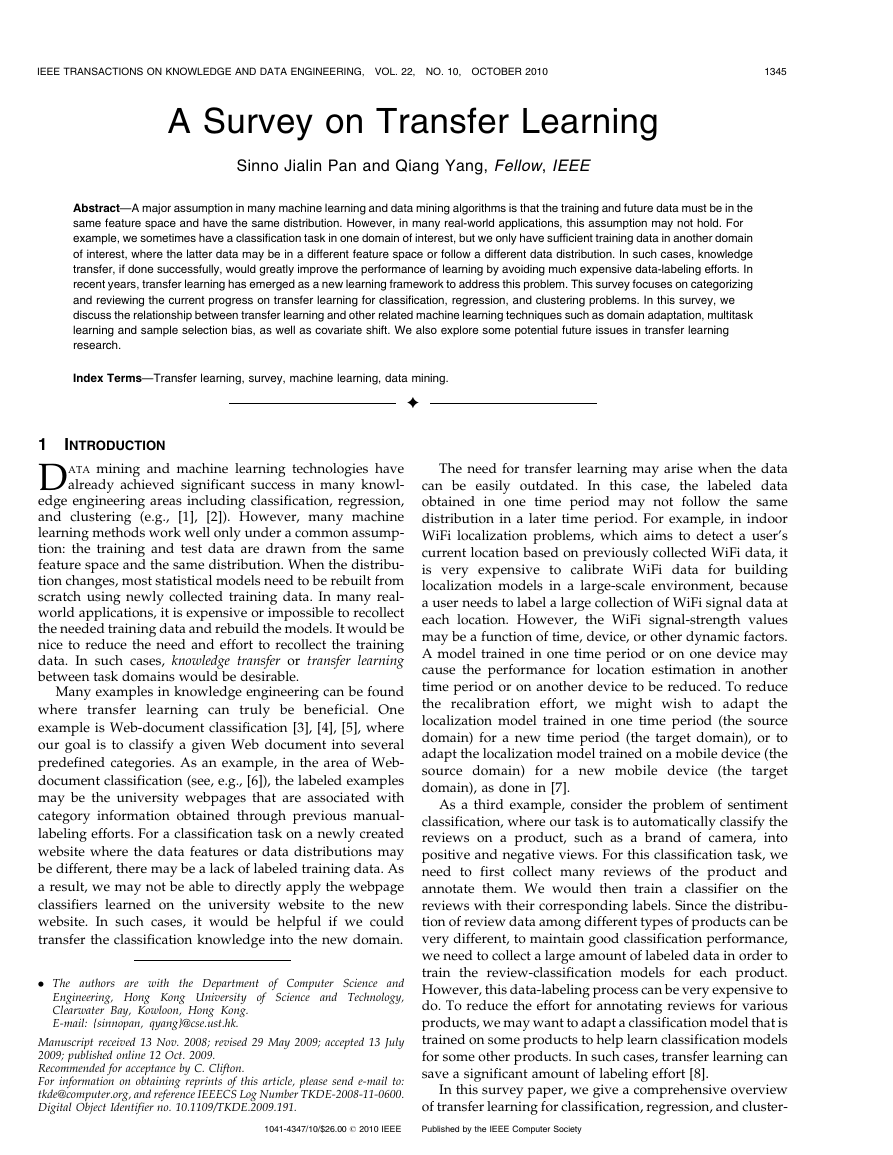
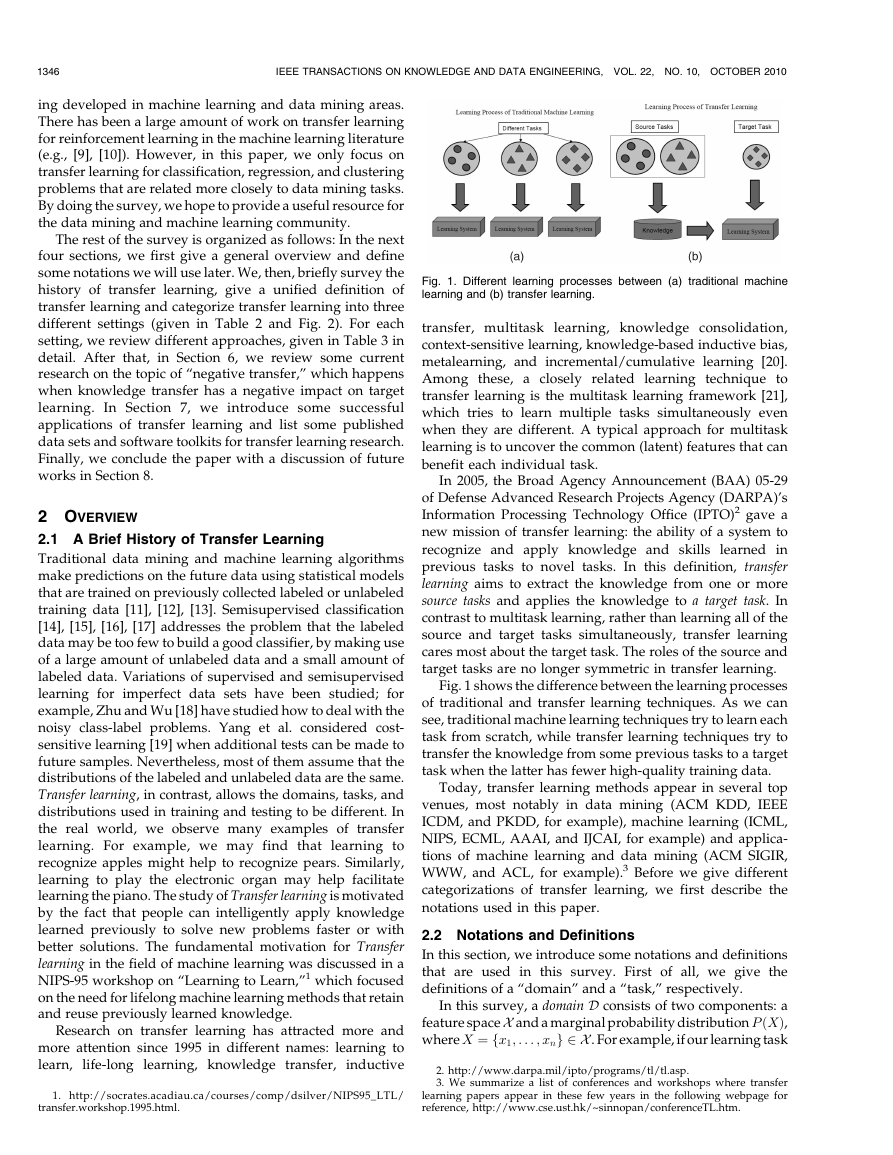
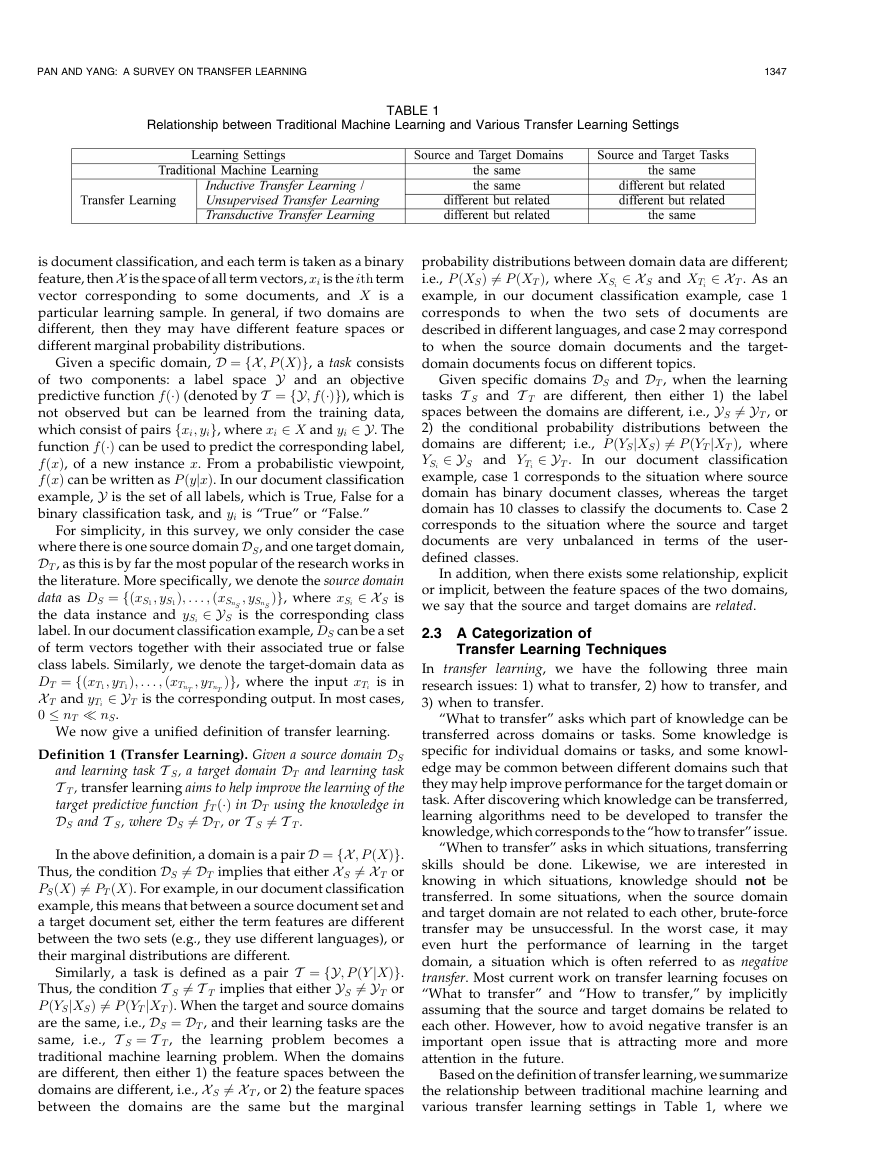
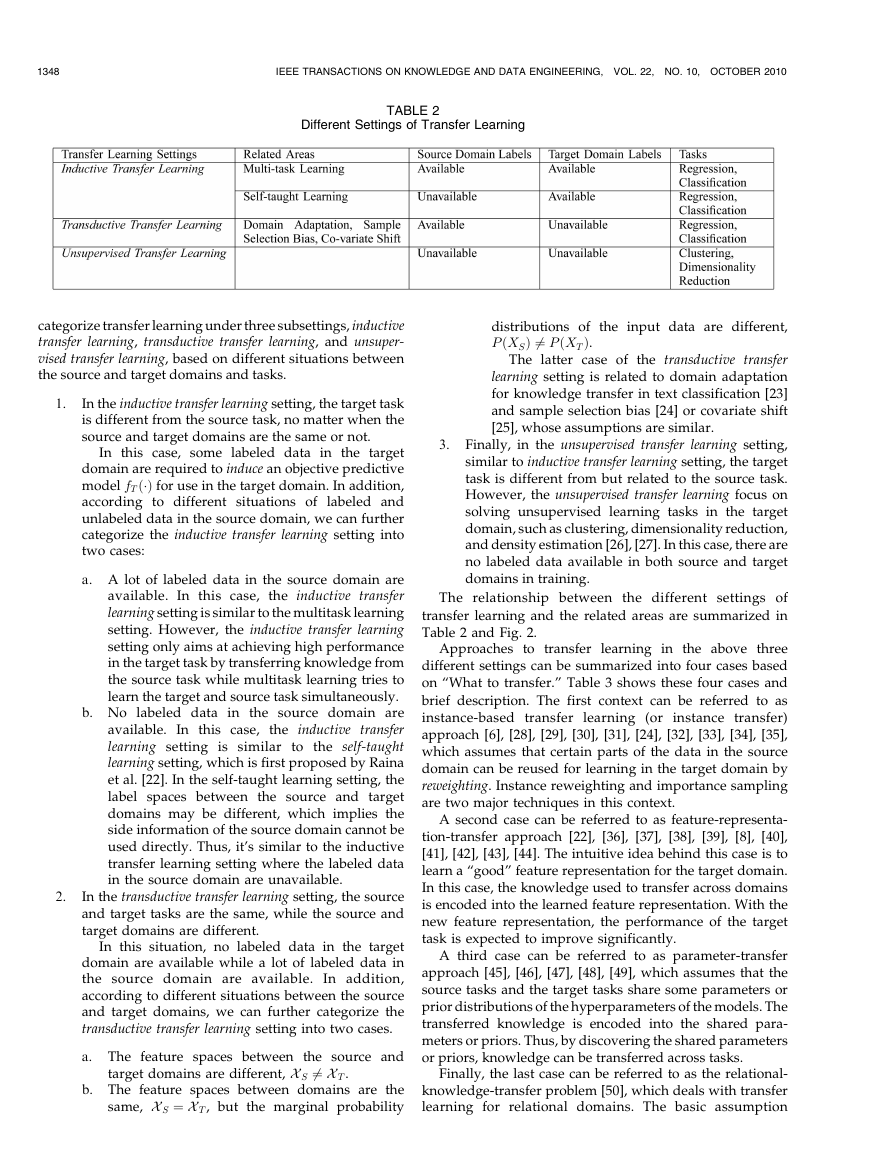
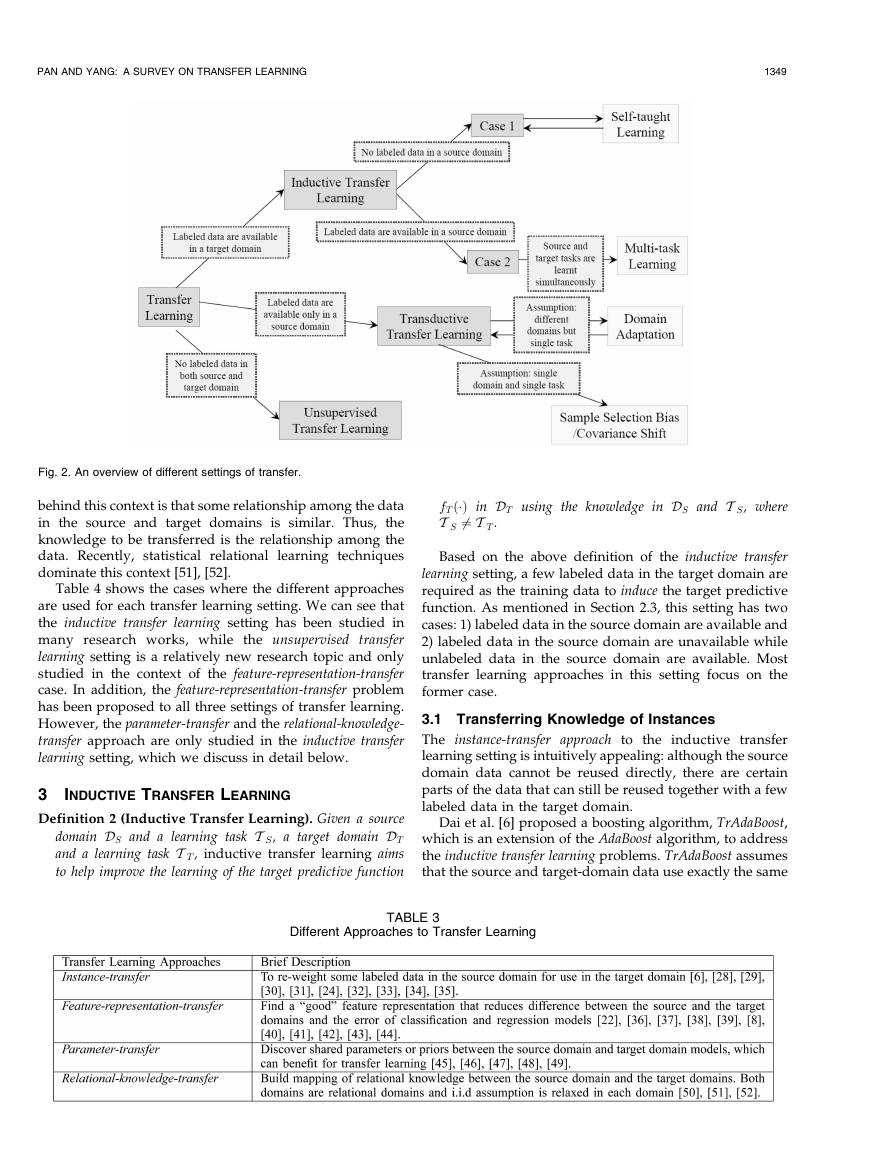
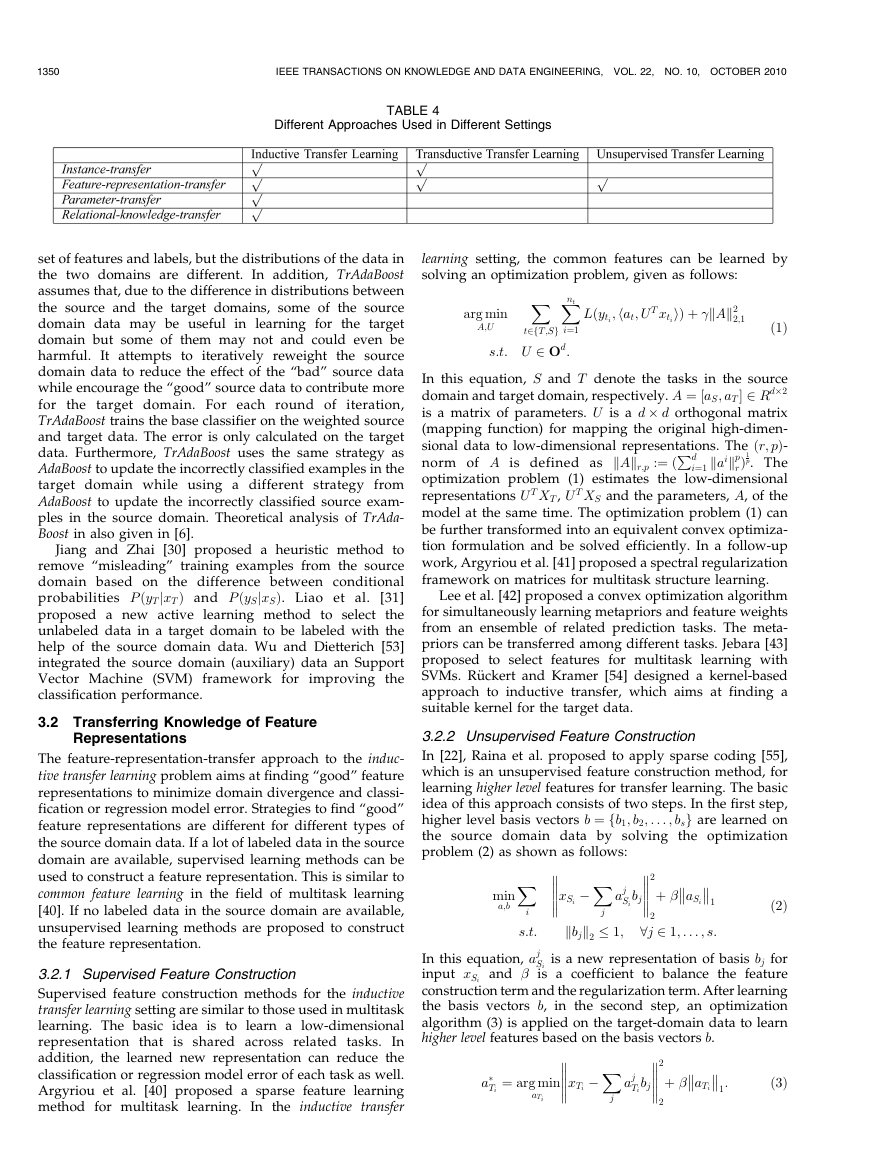
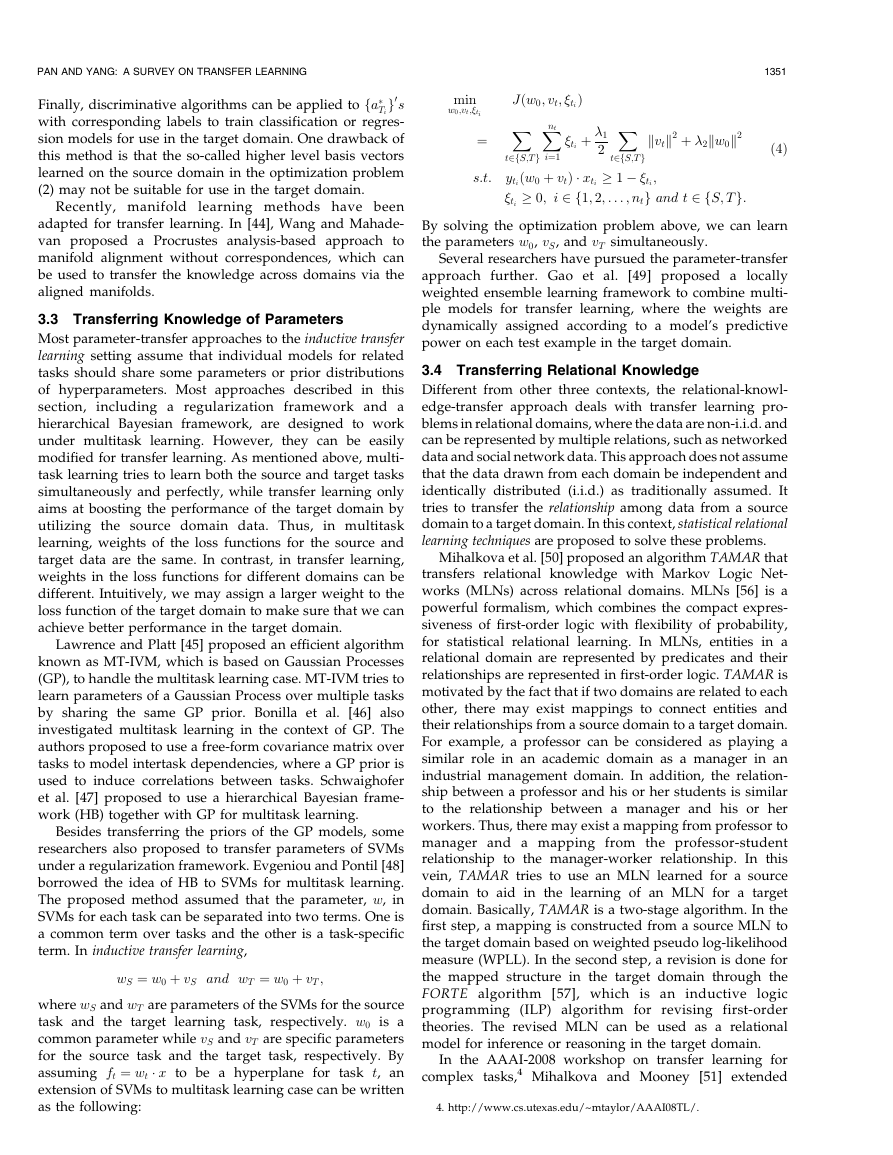
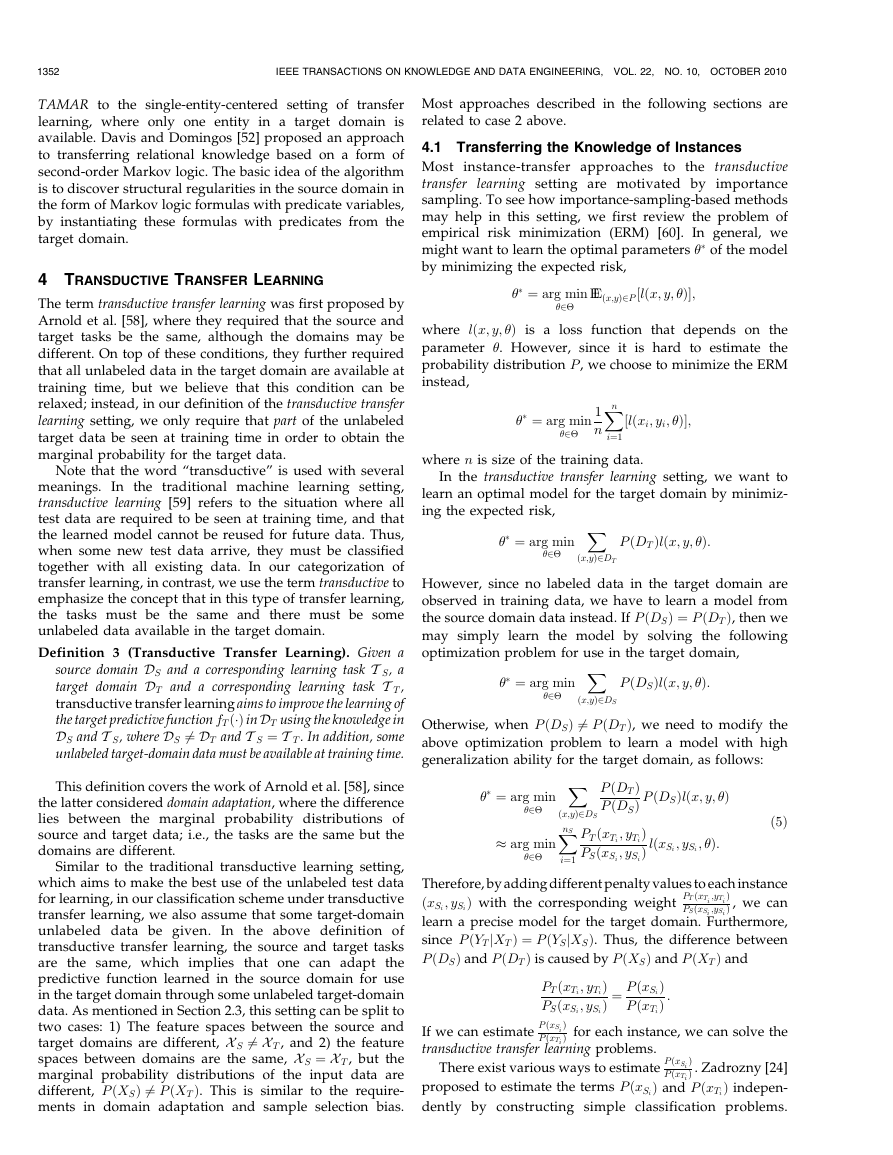








 2023年江西萍乡中考道德与法治真题及答案.doc
2023年江西萍乡中考道德与法治真题及答案.doc 2012年重庆南川中考生物真题及答案.doc
2012年重庆南川中考生物真题及答案.doc 2013年江西师范大学地理学综合及文艺理论基础考研真题.doc
2013年江西师范大学地理学综合及文艺理论基础考研真题.doc 2020年四川甘孜小升初语文真题及答案I卷.doc
2020年四川甘孜小升初语文真题及答案I卷.doc 2020年注册岩土工程师专业基础考试真题及答案.doc
2020年注册岩土工程师专业基础考试真题及答案.doc 2023-2024学年福建省厦门市九年级上学期数学月考试题及答案.doc
2023-2024学年福建省厦门市九年级上学期数学月考试题及答案.doc 2021-2022学年辽宁省沈阳市大东区九年级上学期语文期末试题及答案.doc
2021-2022学年辽宁省沈阳市大东区九年级上学期语文期末试题及答案.doc 2022-2023学年北京东城区初三第一学期物理期末试卷及答案.doc
2022-2023学年北京东城区初三第一学期物理期末试卷及答案.doc 2018上半年江西教师资格初中地理学科知识与教学能力真题及答案.doc
2018上半年江西教师资格初中地理学科知识与教学能力真题及答案.doc 2012年河北国家公务员申论考试真题及答案-省级.doc
2012年河北国家公务员申论考试真题及答案-省级.doc 2020-2021学年江苏省扬州市江都区邵樊片九年级上学期数学第一次质量检测试题及答案.doc
2020-2021学年江苏省扬州市江都区邵樊片九年级上学期数学第一次质量检测试题及答案.doc 2022下半年黑龙江教师资格证中学综合素质真题及答案.doc
2022下半年黑龙江教师资格证中学综合素质真题及答案.doc